Seoul is the biggest and, arguably, most famous city in all of Korea. It boasts a population of just over 10 million across over 600 kilometers. You don’t have to pretend like you know exactly what 600 kilometers looks like (I don’t), but just know that it is pretty big.
The size and density of the city of Seoul makes for an intimidating experience if you’re new to the area. But have no fear! The Seoul subway system is known to be one of the best in the world, up there with the likes of London and Tokyo. Daunting at first with its 20 lines, but the Seoul subway system is marvelous if you understand it.
The lines you need to know.
Let’s start off with a quick look at the necessities, the most important lines that you will definitely use at some point.
First, the Airport Line. This line is essential if you want to make your first day in Seoul super easy. Running from Incheon International Airport all the way into the heart of Seoul at Seoul Station, this line is cheap and easy and will definitely make travelling from the airport super stress free. Along the way, you can also get off at hotspots Digital Media City and Hongik University.
Check the Airport Line out on the map below, in light blue.
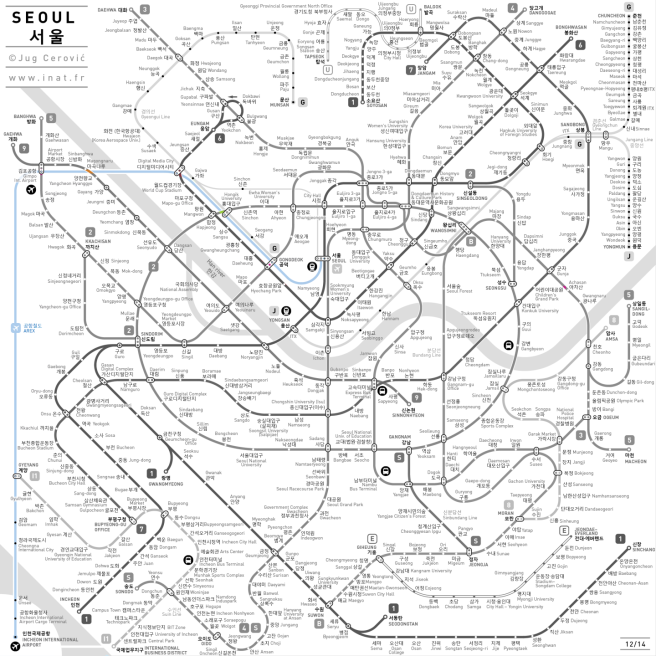
Second, Line 2, or the green line if you’d prefer to go by colors.
There is one line, the most important in my opinion, that circles pretty much the entirety of Seoul. This is Line 2. Via this line, you can reach walking distance of so many tourist destinations, including historic Gwanghwamun Plaza and hip Gangnam.
Line 2 is outlined in green below.
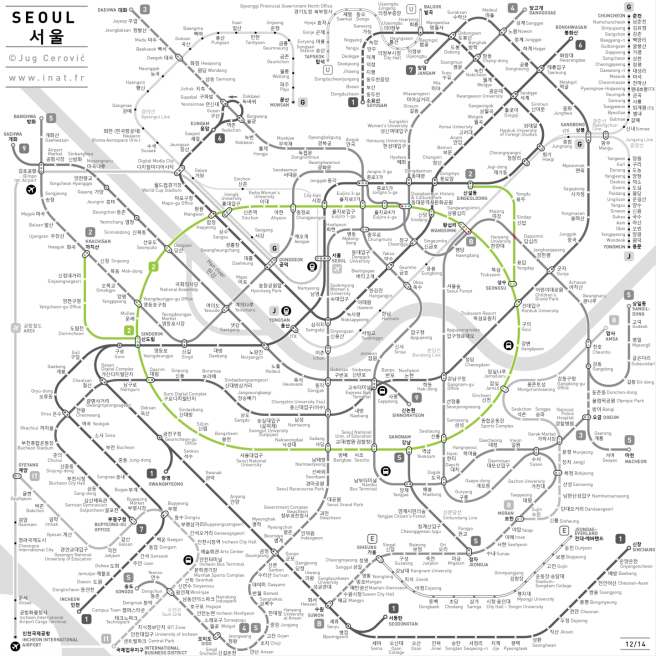
Third, Line 4, or the light blue line. Line 2 does a good job of getting you West and East of Seoul, with quite a few stops along the North and South. However, for the very North and very South of Seoul, you’re going to rely heavily on Line 4.
This line cuts directly in the middle of Seoul and, when combined with Line 2, divides Seoul into four nice quadrants that contain a majority of all the must-see spots.
Take a look at line 4, in blue below.
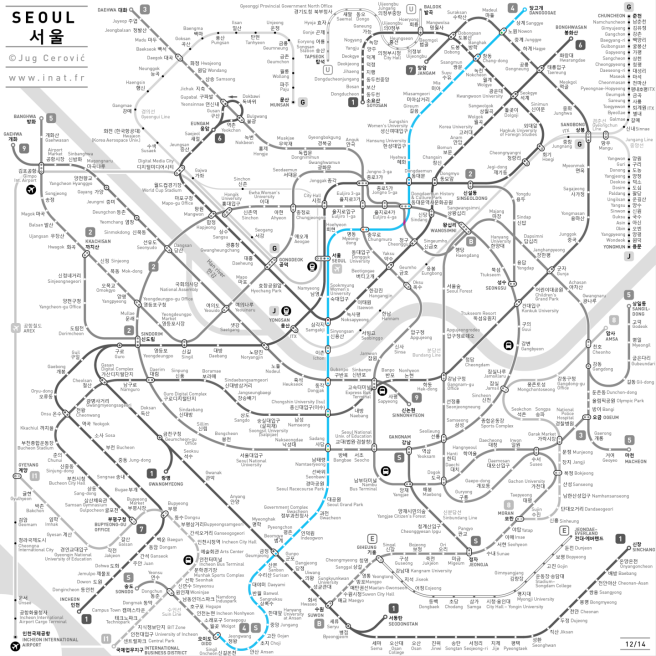
Of course, I’m definitely not saying that you should only rely on these three lines, but they are definitely the main ones that you’ll end up using so they’re good to know.
T-Money is my favorite kind of money.
I come to Seoul from Philadelphia where, the last time I was there, they still relied on tokens. So, changing to a card-based subway system was like being reborn, but in a much more efficient universe.
Seoul’s subway card is called “T-Money.” The “T” in the name apparently stands for “transportation” and is used to signify the ability of a T-Money holder to access many modes of transportation. And that you can!
T-Money doesn’t just come in card form, but can also be purchased as a phone keychain or some banks even offer you to sync your T-Money with your debit card. Very convenient!

But, for the sake of this beginner’s guide, let’s assume that you go for the traditional card form, pictured above. These T-Money cards can be purchased in stations or convenience stores. Every single station has a recharging machine for easy access if you need to top up your card.
You can use these cards on all forms of public transit, not just subway lines. Also, in the past decade or so, pretty much every other major city in Korea, not just Seoul, has adopted T-Money for their public transit systems as well, making for easy travel in-country.
But one of the best things about T-Money? They can be used beyond just public transit. Yep, you can use your T-Money when you’re paying for a taxi, in most convenience stores, and even with some affiliated businesses. T-Money is quite the versatile product.
Exits help you even after you’re above ground.
At every subway station, you are going to be faced with a series of exits. In the United States, we are used to exits being associated with a direction, like North or South, or with a street names. In Seoul, exits are simply marked with numbers. Let’s look at an example. This is Sinsa Station, which is close to popular destination Garosugil.
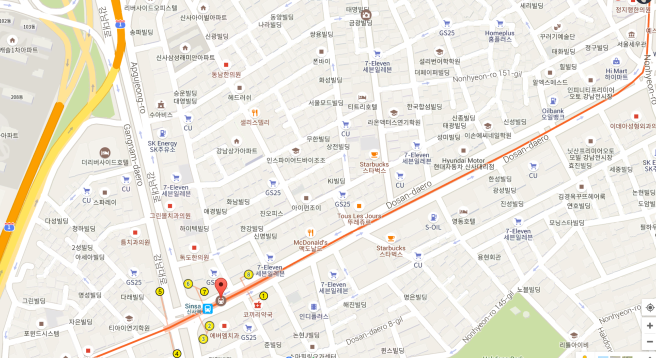
Sinsa Station has 8 exits in total. On the map, we can see how these exits line the station, jutting out in different directions.
Let’s say we are trying to get to Garosugil, which is highlighted in pink, so which exit should we take? The clear answer based on this map is 8.
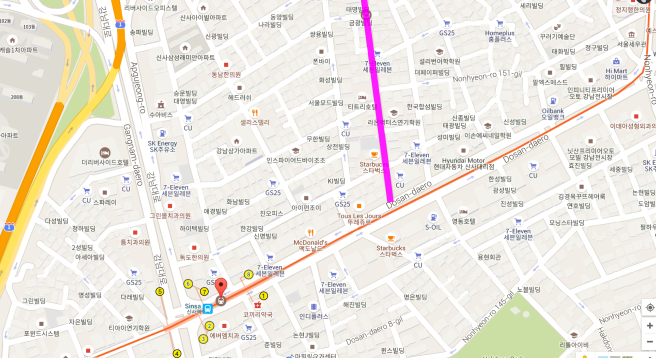
Now, this is a simple concept. Anyone, no matter what level of familiarity with Seoul and its subway system they’re on, will know that to get to Garosugil, you should take exit 8 out of Sinsa Station. However, the longer you live in Seoul, the more you’ll come to understand that these subway exits become the meeting places and guidelines for how to get to places within Seoul.
When you go out with friends, you’ll always meet at a subway station exit, even if you didn’t take a train to get there. Similarly, you would never say “Go North along Gangnam Rd.” but rather “If you’re coming out of Gangnam Station, exit 11, head straight.” Exits become so much more than just a means to leave the underground.
The subway system of Seoul is a vast and intense one, but that doesn’t mean you should be frightened of it. In fact, I would say just the opposite. The underground here is honestly one of my favorite parts about living in Korea, as its reliability and convenience make for an easy daily commute.
What is the public transit like where you live? How does it compare to Seoul’s system? Let me know in the comments!

Wow! Although it is maze-like, the Seoul subway system is surprisingly organized. I imagine I would have less frustration with morning commute taking the Seoul system. Unfortunately I cannot say the same for SEPTA. Since I live in South Philly, I am dependent on Septa for transportation, but as recent events have shown, they are not very reliable. Just this morning, on my commute to work, no one knew that the westbound MFL train is using the eastbound lane. So we were all dumbfounded and waited over 10 minutes before realizing that our train was on the other side. Oh, and don’t even get me started on the SEPTA Key passes.
I’m glad that you’re having a better experience with the Seoul system! SEPTA can definitely learn a thing or two from them!
LikeLike
Oh man I do NOT miss SEPTA hahaha. Coming to the Seoul system was like a breath of fresh air. I feel like SEPTA is missing a very big opportunity with the Key passes… When done right (as we can see with T-Money) a card-based subway system is super convenient.
LikeLiked by 1 person